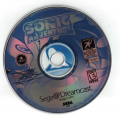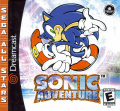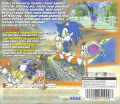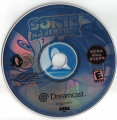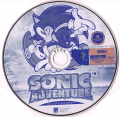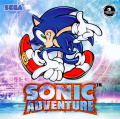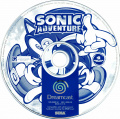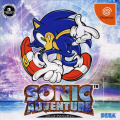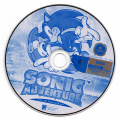Sonic Adventure
From Sonic Retro
- For the GameCube remake, see Sonic Adventure DX: Director's Cut.
| Expression error: Unexpected < operator. |
| Sonic Adventure |
|---|
| System(s): Sega Dreamcast |
| Publisher: Sega |
| Developer: Sonic Team |
| Genre: 3D Platform |
</div>
Sonic Adventure was the first Sonic platformer to be released in full 3D. It was tentatively titled "Sonic RPG" due to the exploration and puzzle-solving elements. It was a title released for the SEGA Dreamcast in 1998, to much fanfare. Playable characters are : Sonic the Hedgehog, Miles "Tails" Prower, Knuckles the Echidna, Amy Rose, Big the Cat, E-102 Gamma, and Super Sonic.
This game took many liberties from previous Sonic games. The artwork was revamped and the level design had a more realistic look to it. It also introduced several new characters such as Big the Cat, the series of E-100 line of robots, and the Chaos. It also had multiple playable characters, each of whom had a unique level selection and separate cutscenes. This is also the first Sonic game which assigns the Super form of characters to a specific level, rather than letting them transform as soon as all the Chaos Emeralds are obtained. This is also the first game in the US that refers to Robotnik under his original Japanese name, Eggman.
Some music tracks in Sonic Adventure are remixed versions of songs in Sonic 3D: Flickies' Island for the Sega Mega Drive (Genesis). One example is the music in the first part of Sonic's run of Twinkle Park (the bumper cars,) is the music that played during the opening cutscene of Sonic 3D.
A VMU minigame called Chao Adventure is included as a downloadable.
Contents
Synopsis/Characters
The game is fixed on the history of Chaos, a mysterious liquid lifeform who was released from the Master Emerald by Dr. Eggman. Eggman planned that if he gave Chaos the seven Chaos Emeralds, he would become a powerful monster. Together they would destroy Station Square and turn it into Eggmanland.
Sonic who was visiting Station Square encountered Chaos. Tails appeared in the city and he and Sonic ran into Eggman in the Mystic Ruins. Eggman revealed his dastardly plan to the two and he grabbed their Chaos Emerald and fed it to Chaos who transformed into Chaos One. Sonic and Tails now are venturing off to find the other emeralds before Chaos gets them.
Meanwhile, Knuckles is searching for the lost pieces of the Master Emerald, after Chaos shattered it. And he is also trying to solve the mystery of the destruction of his ancestors.
Amy Rose gets caught up in the madness, when Eggman's flying fortress, the Egg Carrier, flies over Station Square and a Flicky falls into Amy's arms. She names the bird Birdy and has to protect him from one of Eggman's robots, E-100 Zero.
Newcomer, E-102 Gamma, an artillery robot built by Dr. Eggman for evil purposes is sent to collect a tailed frog, but ends up changing his programming and life forever, when he meets Amy and Birdy. He betrays his master and goes to save his fellow E-100 Series. After destroying E-103 Delta, E-104 Epsilon and E-105 Zeta, Gamma has to face his robotic sibling E-101 Beta. Gamma wins, but Beta damages Gamma and the two explode and are destroyed, releasing the birds within them.
Big the Cat, also a newcomer to the series, gets mixed up in the adventure. Big is a peaceful cat who lives in the jungle with his friend Froggy. But when Froggy gulps down part of Chaos, grows an odd tail and swallows Big's lucky charm (which is actually the yellow Chaos Emerald), Big has to leave his peaceful home to save his best pal from Chaos.
As these six heroes go about on their own missions, a mysterious echidna girl named Tikal teleports them to the ancient past and, through enigmatic flashbacks, shows the history of Chaos, herself and the Chao.
Chaos eventually gains all seven Chaos Emeralds and becomes Perfect Chaos and destroys Station Square. Perfect Chaos destroys the Egg Carrier 2, and it is up to Super Sonic to bring down Chaos, who sees that the Chao are alive and then he and Tikal disappear, presumably to a higher plane because they are now at peace. The world is saved, and Sonic is quickly off on another adventure.
Story Structure
The story is told through the perspective of the character chosen and this results in the stories divulging at certain points based on the character arc. Each character has their viewpoint of a certain scene, so the dialogue between versions tends to be different. This perspective also justifies the different outcomes of certain encounters, for example, when Sonic faces E-102 Gamma on the Egg Carrier, through Sonic's perspective Sonic is about to destroy Gamma, through Tails' perspective Tails is about to destroy Gamma and through Gamma's perspective, Gamma is about to kill Sonic.
Gameplay
The game is divided up into two stages: Action Stages, and Adventure Fields. The division of Action Stages and Adventure Fields was a serious departure from all previous Sonic games.
Action Stages
Action Stages are basically playable levels. This is the only type of area where Sonic or any of his companions will encounter enemies (most boss battles take place in the Adventure Fields, but they are actually in Action Stages designed to look like the Fields.) There are eleven Action Stages, accessible by different characters. However, unlike previous Sonic games, Action Stages are not made up of Zones and Acts. Instead, the game plays more like each Adventure Field is a Zone and the Action Stages are the Acts in the Zone. The Action Stages have separate areas that could be considered "Acts", but they are not separate levels, like in the original Sonic the Hedgehog.
In stages where both Sonic and Tails are present (i.e. Windy Valley, Ice Cap, Sky Deck) Tails can be controlled separately if a second controller is plugged in. The only major downside to this secret is the fact that the second player will have to accurately keep up with player one, as the camera only follows player one and does not form into a split-screen.
Adventure Fields
Adventure Fields are non-linear game stages, generally designed for (light) puzzle solving, exploration, and plot advancement. They contain very few items (enemies, rings, etc.) Every Adventure Field links to the other two Fields and a Chao Garden, where you can raise Chao. They also have four Emblems each. They are each packed with various power-ups for different characters.
There are three Adventure Fields:
- Station Square: a large, metropolitan city, and is the location of Sonic's first fight with Chaos. Eggman plans to destroy it and construct "Eggmanland" on its ruins. This is where Tails fights his final boss.
- Mystic Ruins: a large mountainous area and the largest Adventure Field in the game, containing the (crashed) Angel Island. Deep in the jungle, a Ziggurat can be found. It also has a base home to Eggman. This is where Sonic fights his final boss.
- Egg Carrier: Eggman's massive flying airship. This is the Adventure Field where most characters fight their final bosses (except Sonic and Tails). The Egg Carrier has 2 layouts and multiple transport devices unique to this field.
Real World Inspirations
Sonic Team traveled to many places to compile footage for and get ideas for designing the stages, including Chichen Itza, Cancun, Tulum, Tikal, Cuzco, and Ica. Many of the textures for the ancient ruins located in the game were created from real photographs the team took during their trip. It's also stated that Yuji Naka became very ill during one of these trips.
Downloadables
These are downloadables that were compatible with Sonic Adventure and Sonic Adventure International.
- Christmas: Three Christmas trees which play Joy to the World or Jingle Bells are placed in Station Square. Available at release on 12/23/98 - 12/25/98.
- 1st nationwide ranking added on 12/24/98.
- Kadomatsu: A kadomatsu New Years decoration is placed. Available 12/26/98 - 01/07/99 (a bug fix version was added on 12/29).
- 2nd nationwide ranking added on 01/08/99.
- 3rd nationwide ranking added on 01/13/99.
- QUO contest: A contest where contestants locate 6 Hidekazu Yukawa Quo cards which are hidden around Station Square and Mystic Ruin in a 10 minute time limit. It was released 01/22/98.
- 4th nationwide ranking added on 02/12/99.
- Famitsu contest: A contest which was sponsored by Famitsu magazine. 5 hedgehog photos are hidden around Station Square and must be found in a 10 minute time limit. It was released 02/12/99.
- 5th nationwide ranking added on 03/17/99.
- 6th nationwide ranking added on 04/07/99.
- 7th nationwide ranking added on 04/22/99.
- Chao black market added on 06/08/99. Players with enough Emblems can access rare Chao.
- 8th nationwide ranking added on 06/17/99.
- 9th nationwide ranking added on 09/02/99.
- Launch Party!: Banners and balloons are placed around Station Square to celebrate the US Dreamcast launch. Released 09/09/99.
- Ruby Chao available for download on 09/09/99.
- Eme Chao (Emerald Chao) available for download on 10/14/99.
- Halloween Party: Twinkle Park is decorated with jack-o-lanterns decorated with witch hats and black capes. Released 10/18/99.
- Merry Christmas: Decorates Station Square with 2 large christmas trees. If either tree is tagged "Dreams Dreams A Cappela" from Christmas NiGHTS will play. Released 12/17/99 - 12/28/99.
- Sappha Chao (Sapphire Chao) available for download on 12/23/99.
- Neo Millennium: Two giant rings are hidden in each action stage. If it is tagged the BGM will changed to Palmtree Panic present BGM from Sonic the Hedgehog CD. Released 12/29/99.
- Samba GP: A Twinkle Circuit course is added to mark the release of Samba de Amigo on the dreamcast. The BGM for the track is Super Sonic Racing (instrumental version). It was released 04/27/00.
Trivia
- Conceptualized by Takashi Iizuka (who would later go on to form Sonic Team USA and later Sega Studios USA), he originally envisioned this game as a "Sonic RPG", leading to many rumors of a "Sonic & Knuckles RPG" prior to the game's unveiling in August, 1998.
- The city featured in the opening introduction sequence and in the loading screen for Station Square bears a striking resemblance to Manhattan.
- The game was originally intended to run at 60fps (or frames per second); however, it suffered from fatal bouts of slow down, so the framerate was later lowered to 30fps (strangely though, the mini-game Twinkle Circuit is running on perfect 60fps). The GameCube port, Sonic Adventure DX, attempted to restore the game's original framerate, but due to timing issues and the unstable nature of the Sonic Adventure engine, the framerate randomly fluctuates between 60fps and 30fps, sometimes even going as low as 20fps.
- Many stages underwent repeated heavy revisions as Sonic Team got a feel for how Sonic should play in 3D; one of the stages that received the most changes was Windy Valley.
- Just before Sonic transforms into Super Sonic, a crowd of people can be heard chanting "Sonic! Sonic!" - the Japanese language chants were actual people chanting, recorded live when Sonic Adventure was unveiled publicly in 1998. Japanese Sega Saturn mascot Segata Sanshiro was responsible for getting the crowd to chant.
- This was the final game Sonic's original designer, Naoto Ohshima, was credited for. It is rumored he left the company after a dispute with Yuji Naka over the direction they wanted the Sonic series to take after Sonic Adventure. Naoto Ohshima's name was removed from the credits for Sonic Adventure DX: Director's Cut for unknown reasons.
- When Amy Rose remembers "the good old days", she is actually remembering the time Sonic saved her from Metal Sonic in Sonic CD. In that very same background shown in that particular scene, it is the prototype version of Windy Valley before its revision. She also was wearing her new outfit during that memory instead of wearing her previous outfit at the time.
- Both Metal Sonic (Sonic CD) and Mecha Sonic (Sonic the Hedgehog 2) are on display in the Adventure Field for Final Egg.
- The main enemy of the game, the water monster named "Chaos", was designed specifically to be an enemy that could not be rendered on previous generations of hardware.
- Comic adaptations of Sonic Adventure have been produced by both Archie and Fleetway. Archie Sonic issues 79-84 and a 48-page special (of same name) covers this game. The Fleetway adaptation of this game is the final story arc for their continuity.
- There are minor differences between the December 1998 Japanese release of Sonic Adventure and the September 1999 American release. In the Japanese release, the lip syncing for dialogue matches what they say in Japanese; in the English release, lip syncing doesn't precisely match what they say in English or Japanese. Other improvements were implemented in the American version to help patch problems with collision detection and camera control.
- Before the Dreamcast's launch, Sega and Hollywood Video teamed up for a promotion that let you rent Dreamcast consoles. The system came with Sonic Adventure: Limited Edition. This was the Japanese release Sonic Adventure with translated English subtitles. Only a few copies of this game exist; and according to Tips and Tricks Magazine, it is the rarest Sega Dreamcast game.
- The Easter Egg Chao Adventure has a notable glitch: if you use a third-party VMU instead of the original, the VMU will experience erratic behavior.
- There were tons of secrets and glitches that were discovered by hacking the game, including character models. By using various glitches, players can have the characters in levels or areas of the action stages that were not able to access to in the final game. Levels included Tails in Emerald Coast, Knuckles in Sonic's Lost World area, and Amy in Casinopolis (only in the Japanese version).
- Angel Island (where the Master Emerald's shrine is) is a real island to the north of San Francisco and Alcatraz Island. Sega of America is also headquartered in San Francisco.
- There are unused voice clips of a Super Sonic tutorial, which hints that Super Sonic was going to be playable in more than just the final stage at one point.
- In the final story Birdie is notably not with Amy, but Gamma's flicky instead.
- The E-105 Zeta boss incorporates Dreamcasts as part of its structure.
- When Amy is walking with her groceries in her the first cut scene of her gameplay and the final image at the end of her story, the paper bag has the words "YU2-MART" on it. YU2 is Yuji Naka's nickname.
Manuals
Also Released On
- Sonic Adventure for Tiger LCD (2000)
- Sonic Adventure for Xbox Live Arcade and Playstation Network (2010)
Voice actors
| Role | English Voice Actor | Japanese Voice Actor |
|---|---|---|
| Sonic the Hedgehog | Ryan Drummond | Jun'ichi Kanemaru |
| Miles "Tails" Prower | Corey Mitchell Bringas | Kazuki Hayashi |
| Knuckles the Echidna | Michael McGaharn | Nobutoshi Kanna |
| Amy Rose | Jennifer Douillard | Taeko Kawata |
| Big the Cat | Jon St. John | Shun Yashiro |
| E-102 Gamma | Steve Broadie | George Nakata |
| Doctor Eggman
/Doctor Ivo Robotnik |
Deem Bristow | Chikao Otsuka |
| Tikal | Elara Distler | Kaori Aso |
| Pachacamac | Steve Broadie | Toru Okawa(?) |
| Announcer A, Egg Carrier
computer, off-screen citizen |
Lani Minella | ??? |
| Announcer B | ??? | Yuji Naka(?) |
Except for the initial Japanese 1998 release which was fully and only in Japanese, all regional versions of the game feature options to switch the voice language into Japanese and English and the text language into Japanese, English, German, French and Spanish.
Production Credits
For a complete list of the games production credits please click the following link: Sonic Adventure credits
Physical Scans
- SA1 Limited Edition.png
Limited Edition GD
Artwork
| |
Main article: Artwork for Sonic Adventure |
| Sonic Adventure / Sonic Adventure DX: Director's Cut | |
|---|---|
|
Main page (SADX|2010) Manuals (SADX) Development (SADX) |
show;hide
Adventure Fields: Sub-games: Dreamcast Prereleases: DX Prereleases: 2010 Prereleases: Books:
Comics: Music: Songs: "Open Your Heart" | "It Doesn't Matter" | "Believe in Myself" | "Unknown from M.E." | "My Sweet Passion" | "Lazy Days ~Livin' in Paradise~" |
| Sonic the Hedgehog games for the following systems | |
|---|---|
| 1998 Sonic Adventure 1999 Sonic Adventure International 2000 Sonic Shuffle 2001 Sonic Adventure 2 | Sonic Adventure 2 Birthday Pack | Sega Smash Pack Volume 1 | |


